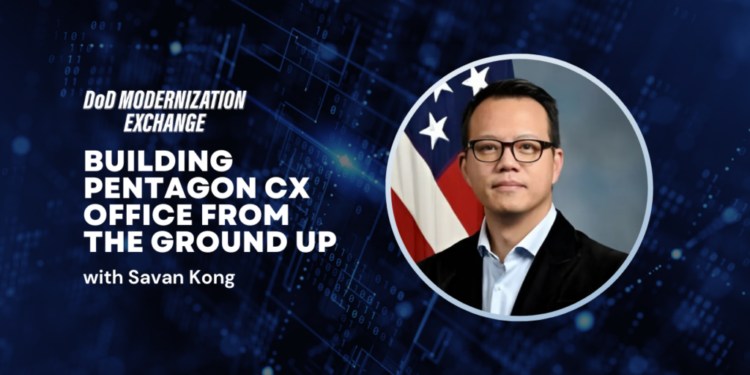When Savanrith “Savan” Kong, who until recently stepped down as the first-ever customer experience officer for the Defense Department, was asked to lead the brand-new CXO Office, he asked then-Chief Information Officer John Sherman what that would entail. The answer? “We don’t yet, but we’ll figure out as we go.”
Nearly 18 months later, the office has matured into an organization driving meaningful, enterprisewide change.
“Our superpower is in our ability to see the landscape, be able to get a broad understanding of what the needs are but then be able to put together the policies and the oversight needed for us to really sort of impact change at a global enterprise level,” Kong said during Federal News Network’s DoD Modernization Exchange.
Improving CX for DoD agencies, military service members, civilian employees and Defense partners has long been a priority for the Pentagon. The catalyst for standing up the office was a widespread recognition that CX needed serious improvement across the department.
For instance, in 2022, DoD personnel launched a viral social media campaign calling on senior leaders to “Fix our computers.” And in 2023, the Defense Business Board found that user experience was average or below average across DoD.
Building a CX Office from scratch
Creating the new organization from the ground up within a bureaucracy such as DoD required strong leadership support but also the ability to clearly define and communicate what customer experience actually meant within the department.
“If you were to ask 100 people, you’re probably going to get 100 different answers as to what that means. So, for us, it was really important to focus on what that language meant and then be able to take that and articulate it throughout the department,” Kong said.
“We’re a global organization, and you’re going to have competing priorities all the time. Anytime we go into a situation, we have to be able to present clearly why customer experience is important, why focusing on the outcomes of our users is important to the mission. And then, what can we do to affect those changes?”
Another challenge the office faced was not just presenting a vision for improving CX but also crafting a plan that would mobilize commitment from organizations across DoD.
“There’s just so broad of a landscape that it makes it somewhat hard at times to really get people to focus on key things that we can actually start to mobilize against and deploy them in a way where it’s efficient and people can understand why we’re making those investments,” Kong said.
Early on, he said, the CX Office identified and decided to focus on four core pillars that would “make it unique” within the department:
- Strategic guidance: Captured in the Fulcrum IT advancement strategy, the pillar “sets the tone and gives you the directions to get there,” Kong said.
- IT governance: The pillar focused on governing IT in an effective way where “you can actually see and get a pulse of the things that are working versus not working,” he said.
- Performance management: This pillar focused on a data-driven approach to align metrics and outcomes with the business needs of the organization. “What that did is it took a lot of the subjectivity out of what user experience is, and it started to make it a lot more tangible for people,” Kong said.
- User experience: The culmination, or the “tail-end piece, ” is continual experience improvements for all stakeholders — the result of a journey driven by strategy, governance and measurable performance, he said.
Getting a baseline for CX across DoD
In its first year, the CX Office mostly focused on understanding the current state of customer experience capabilities across DoD. The goal was to establish a baseline and figure out what organizations were already doing — things like collecting user feedback — and whether those efforts were being done efficiently.
The office also wanted to know if Defense organizations had the people and processes in place to gather experience feedback consistently over time.
“That was the biggest initiative in year one — getting the baseline, understanding what that looks like, and then from there, we can start to actually be a lot more precise,” Kong said.
“With the new administration, I’m looking forward to however they’re going to go about doing that. Especially with some of the changes with artificial intelligence and tooling, I think there’s a lot more efficient ways that you can start to get information and feedback from users.”
The team didn’t start with zero data. It inherited a set of metrics — like PC boot-up time — that seemed simple to collect. It turned out that gathering metrics across an organization the size of DoD was not simple at all, Kong said. Across the department, it’s numerous disparate organizations have varied and inconsistent data structures and also measure things in different ways.
“The minutia of just the language and expectations was something that we had to get down very quickly because we’re asking these people to invest time and effort and money into these baseline metrics,” he said. “If we don’t have the common consensus of what that looks like, then our results will be all over the place.”
Bringing DoD teams together to collaborate on CX
The baseline work led to a first-ever UX consortium — an initiative that brought together stakeholders, subject matter experts and leaders across military departments and agencies.
Kong described that as a “powerful” moment. The consortium created a space where people gathering those baselines were able to ask questions and align on best practices.
“Before something like the CXO was stood up, that was impossible to do. You couldn’t just walk into another office and ask those questions just because of the nature of how big the department is,” he said.
“If you were to ask, ‘What are some of the most important things we had done?’ If I were to simplify it, it’d be just pulling people together was very, very hard because of the nature of our mission and the nature of the priorities. To be able to do that was exceptionally important.”
Discover more articles and videos now on the DoD Modernization Exchange event page.
Copyright
© 2025 Federal News Network. All rights reserved. This website is not intended for users located within the European Economic Area.







